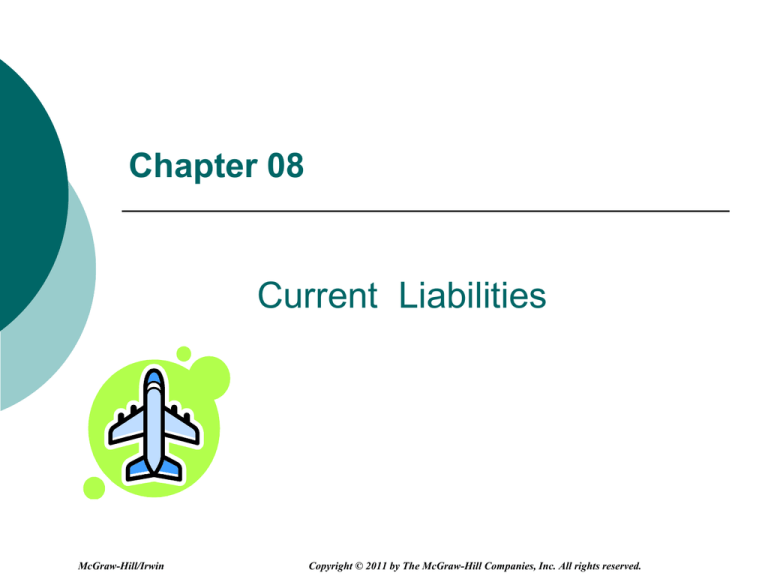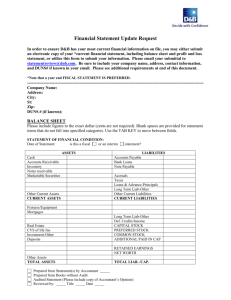
Chapter 08
Current Liabilities
McGraw-Hill/Irwin
Copyright © 2011 by The McGraw-Hill Companies, Inc. All rights reserved.
Part A
Current Liabilities
8-2
Current Liabilities
Liability - A present responsibility to sacrifice assets
in the future due to a transaction or other event
that happened in the past.
o
o
Current liabilities are usually, but not always, due
within one year. Notes payable, accounts payable,
and payroll liabilities are the three main categories.
_ Note: If a company has an operating cycle longer
than one year, its current liabilities are defined by
the operating cycle rather than by the length of a
year.
Current liabilities are also sometimes called shortterm liabilities.
8-3
LO1 Distinguish between current and
long-term liabilities
Reporting Liabilities
Three characteristics of liabilities:
o probable future sacrifices of economic
benefits.
o arising from present obligations to other
entities.
o resulting from past transactions or events.
8-4
Current vs. Long-Term Liabilities
LIABILITIES
CURRENT
Payable within one
year
LONG-TERM
With in the
Payable
more
company
than
one year
8-5
Reporting Current Liabilities
o Distinguishing between current and long-term
liabilities helps investors and creditors assess
risk.
o Companies often prefer to report a liability as
long-term because it may cause the firm to
appear less risky.
o Many companies list notes payable first, followed
by accounts payable, and then other current
liabilities from largest to smallest.
8-6
LO2 Account for Notes Payable and
Interest Expense
o Notes Payable
o A company borrowing cash (borrower) from a bank is
required to sign a note promising to repay the amount
borrowed plus interest.
o The borrower reports its liability as notes payable.
o Notes payable is a liability that creates interest expense
o Small firms rely heavily on short-term financing.
o Large companies also use short-term debt as a
significant part of their capital structure.
8-7
LO3 Account for Employee and
Employer Payroll Liabilities
o Prior to depositing a monthly payroll check, an employer
withholds
o Federal and state income taxes,
o Social Security and Medicare,
o Health, dental, disability, and life insurance premiums, and
o Employee investments to retirement or savings plans.
o As an employer, the costs of hiring an employee are higher
than the salary.
o Significant costs include
o Federal and state unemployment taxes,
o The employer portion of Social Security and Medicare,
o Employer contributions for health, dental, disability, and life
insurance,
o Employer contributions to retirement or savings plans.
8-8
Summary of Payroll Costs
Employee Payroll Costs
Federal and state income taxes
Social Security and Medicare
Health, dental, disability, and life insurance
premiums
Employee investments in retirement or
savings plans
Employer Payroll Costs
Federal and state unemployment taxes
Employer matching portion of Social
Security and Medicare
Employer contributions for health, dental,
disability, and life insurance
Employer contributions to retirement or
savings plans
8-9
LO4 Demonstrate the Accounting for
other Current Liabilities
Additional current liabilities companies report:
o
o
o
o
Unearned revenues
Sales taxes payable
The current portion of long-term debt
Deferred taxes
8-10
Part B
Contingencies
8-11
LO5 Apply the appropriate accounting
treatment for contingencies
o Contingent liability:
o An existing, uncertain situation that might result in
a loss.
o Examples: Lawsuits, product warranties,
environmental problems, and premium offers
o A contingent liability may not be a liability at all.
Whether it is, depends on whether an uncertain
event that might result in a loss occurs or not.
8-12
Litigations and Other Causes
Deloitte was the auditor for a client we’ll call Jeeps, Inc. The client
sold accessories for jeeps such as tops, lights, cargo carriers, and
hitches. One of the major issues in Deloitte’s audit of Jeeps, Inc., was
outstanding litigation. Several lawsuits against the company alleged
that the jeep top (made of vinyl) did not hold during a major collision.
The jeep manufacturer, Chrysler, also was named in the lawsuits. The
damages claimed were quite large, about $100 million. Although the
company had litigation insurance, there was some question whether
the insurance company could pay because the insurance carrier was
undergoing financial difficulty. Legal counsel representing Jeeps, Inc.
indicated that the possibility of payment was remote and that if the case
went to trial, Jeeps would almost surely win.
As the auditor, you could choose one of three options to report the
situation: (1) report a liability for the full $100 million or for some lesser
amount, (2) provide full disclosure in a financial statement footnote but
not report a liability in the balance sheet, or (3) provide no disclosure at
all.
8-13
Accounting Treatment of Contingent
Liabilities
If payment is:
Known or Reasonably
Estimable
Probable
Liability recorded and
disclosure required
Not Reasonably
Estimable
Disclosure required
Reasonably possible Disclosure required
Disclosure required
Remote
Disclosure not required
Disclosure not required
8-14
Contingent Liabilities
Back to Jeeps, Inc.
How do you think Deloitte, as the auditor of Jeeps,
Inc., treated the litigation described earlier?
o Based on the response of legal counsel, the
likelihood of the payment occurring was considered to
be remote, so disclosure was not required.
o However, because the amount was so large, and
because there were concerns about the firm’s primary
insurance carrier undergoing financial difficulty, Deloitte
insisted on full disclosure of the litigation in the
footnotes to the financial statements.
8-15
LO6 Assess liquidity using current
liability ratios
o Liquidity Analysis
o Liquidity refers to having sufficient cash to pay currently
maturing debts.
o Working Capital:
o It is the difference between current assets and current
liabilities.
o Current ratio:
o We calculate it by dividing current assets by current
liabilities.
o Acid-test ratio/Quick ratio:
o We calculate it by dividing “quick assets” by current
liabilities.
o Quick assets include cash, short-term investments, and
accounts receivable.
8-16
End of chapter 08
8-17





